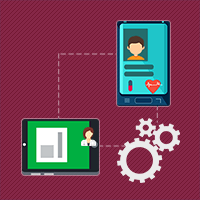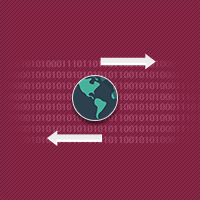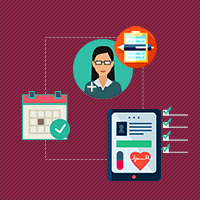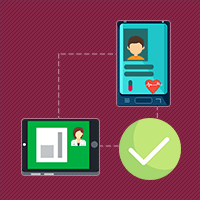6 promising ways mHealth interoperability benefits healthcare
Achieving interoperability between the current mHealth technologies means creating an environment where healthcare organizations and providers can easily access and share medical information with their patients.
It can streamline care coordination and improve the quality of medical care outcomes in the following ways:
1. Greater efficiency
 Healthcare industry has always struggled with the challenge of creating end-to-end solutions. Designing such a solution is resource intensive and time-consuming. Connected mHealth devices have liberated the technologists from the burden of dealing with such complexity.
Healthcare industry has always struggled with the challenge of creating end-to-end solutions. Designing such a solution is resource intensive and time-consuming. Connected mHealth devices have liberated the technologists from the burden of dealing with such complexity.
mHealth interoperability ensures that technologists can solely concentrate on the specialized tool. They don’t need to understand the overall system. Wireless protocols take care of the integration aspects.
New technology companies can enter the market and introduce innovations and improvements to the existing tools without mastering the overall system. This leads to better-designed tools that are easier to use and more energy efficient. From payments to monitoring chronic diseases to administering medicine, technologists can isolate the efficiency problems and find resolutions.
2. Lower costs

Technology integration can significantly impact healthcare spending. According to PricewaterhouseCoopers research, Europe can save 35 percent of its healthcare cost for chronic diseases through the use of mHealth technologies. In the US, overall healthcare spending is a fifth of the country’s domestic product. A similar undertaking like Europe would mean a $700 billion savings for the US.
Interoperability in healthcare saves time and labor cost of device integration. Today connected electronic medical record (EMR) devices can be set up only in a few weeks. Previously, it used to take months to set up a traditional device. This means large savings for the healthcare industry.
Also, healthcare workers can easily carry monitoring devices to remote locations and disaster areas. These mHealth devices provide the necessary analysis in the absence of large-scale hospital infrastructure. Patients get the care they need at a fraction of the cost.
3. Streamlined workflows
 mHealth solutions are changing the way doctors, patients, and insurance companies interact with each other.
mHealth solutions are changing the way doctors, patients, and insurance companies interact with each other.
Connected apps are helping patients better understand their own health needs and forwarding this information to their doctors. These apps are also keeping track of medical treatment costs and ensuring that doctors save time on paperwork. This way, they can help in reducing physician burnout.
It has also automated the prescription process. Now physicians are prescribing medicine through applications connected to the pharmacies.
Insurance companies are automating financial transactions and providing real time support through these apps. With the saved time and person-hours, insurance companies can concentrate more on improving their operations.
Maintaining records and payment procedures is a complex ecosystem. Integrated mHealth technologies are simplifying this ecosystem for all the stakeholders.
4. Universal data exchange

mHealth interoperability benefits healthcare by resolving one of the biggest problems of the medical establishment — sharing patient information. Even with Electronic Health Records (EHR) and Health Information Exchange (HIE), data sharing between doctors have been slow due to the cost of implementation. Connected apps can significantly lower the costs and make universal data exchange possible.
HIE already defines direct exchange, query-based exchange, and consumer-mediated exchange. Lots of health providers have implemented these electronic solutions. But the variety of implementation makes it difficult for these exchanges to talk to each other.
With healthcare interoperability standards built into the mhealth device specifications, it is possible to create low cost alternatives. Also, as more data moves to the cloud, it opens the possibility of a consistent data structure implementation. It would simplify the applications to connect to each other.
5. Trusted healthcare coordination

Interoperability of mHealth technology assures data accuracy and integrity throughout all mobile devices. This builds a sense of trust between the caregivers and the patients. Both can look at the same data and be informed about upcoming decisions.
Any medical decision is based on the analysis of available data. So, the integrity of the healthcare data is important. Without proper oversight, even digital information can be inaccurate and such situations can lead to wrong decisions with dangerous consequences.
mHealth technologies can provide the necessary safeguards to ensure that everyone is on the same page. A physician can be more confident that they have the right information as the patient will be able to verify the records in real-time.
6. Better patient engagement

In recent years, there is a general rise in health awareness. Technology is providing the devices to help people become more health conscious. It is possible for patients to proactively monitor their chronic conditions. But there is a disconnect. Physicians might not have access to the latest data.
Interoperability opens the flow of information. Patients can take better care of themselves using the latest available medical information. Doctors can get the most up-to-date health data.
And as seen through a patients’ perspective, this will motivate healthy lifestyles. For example, when patients are aware that their doctors have information about their cholesterol, they might be more motivated to curb their enthusiasm for a large steak dinner.
Conclusion
Innovations are giving rise to the mHealth technologies. But consumers will determine if interoperability becomes a standard.
The next steps in healthcare technology strategy should be towards increased adoption of interoperability to achieve overall patient and provider satisfaction.
How do you think healthcare will benefit from interoperability? Share it with us in the comments section below or tweet it to us!


